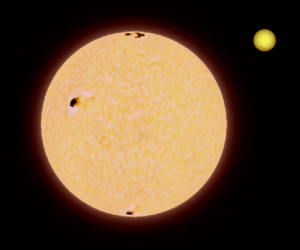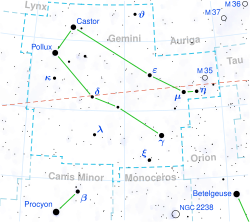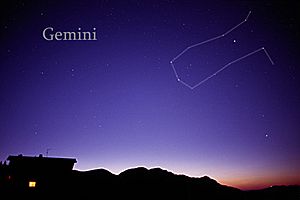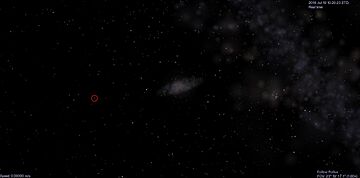Pollux (star) facts for kids
| Observation data Epoch J2000.0 Equinox J2000.0 |
|
|---|---|
| Constellation | Gemini |
| Right ascension | 07h 45m 18.94987s |
| Declination | +28° 01′ 34.3160″ |
| Apparent magnitude (V) | 1.14 |
| Characteristics | |
| Evolutionary stage | Red clump |
| Spectral type | K0 III |
| U−B color index | +0.86 |
| B−V color index | +1.00 |
| V−R color index | +0.75 |
| R−I color index | +0.50 |
| Variable type | Suspected |
| Astrometry | |
| Radial velocity (Rv) | +3.23 km/s |
| Proper motion (μ) | RA: −626.55 mas/yr Dec.: −45.80 mas/yr |
| Parallax (π) | 96.54 ± 0.27 mas |
| Distance | 33.78 ± 0.09 ly (10.36 ± 0.03 pc) |
| Absolute magnitude (MV) | +1.08+0.02−{{{2}}} |
| Details | |
| Mass | 1.91+0.09−{{{2}}} M☉ |
| Radius | 8.97+0.03−{{{2}}} R☉ |
| Luminosity | 38.4+0.3−{{{2}}} L☉ |
| Surface gravity (log g) | 2.55+0.03−{{{2}}} cgs |
| Temperature | 4,810+14−{{{2}}} K |
| Metallicity [Fe/H] | –0.07 to +0.19 dex |
| Rotation | 660±15 d |
| Rotational velocity (v sin i) | 2.8 km/s |
| Age | 1.19±0.3 (0.9 – 1.7) Gyr |
| Other designations | |
|
β Geminorum, 78 Geminorum, BD+28°1463, GJ 286, HD 62509, HIP 37826, HR 2990, SAO 79666, LFT 548, LHS 1945, LTT 12065
|
|
| Database references | |
| SIMBAD | data |
| Exoplanet Archive | data |
| ARICNS | data |
Pollux is a very bright star in the Gemini constellation. It's often called Beta Geminorum. This star shines with an orange color and is an evolved giant star. It's about 34 light-years away from us, making it the closest giant star to our Sun. Since 2006, scientists have known that Pollux has a planet orbiting it, named Thestias.
Contents
Discovering Pollux: A Bright Star in Gemini
Pollux is the brightest star in the Gemini constellation, even brighter than its neighbor Castor. It shines with an apparent magnitude of 1.14. It's too far north for our Moon to pass in front of it (an event called an occultation). The last time this happened was a very long time ago, in 117 BCE!
Thanks to measurements from the Hipparcos satellite, we know Pollux is about 33.78 light-years away from our Sun. This distance helps astronomers understand how bright the star truly is.
What's in a Name? The Story of Pollux
Its official scientific name is Beta Geminorum. The traditional name Pollux comes from ancient Greek and Roman mythology. It refers to one of the famous twin brothers, Castor and Pollux.
In 2016, a group of astronomers called the International Astronomical Union (IAU) officially approved the name 'Pollux' for this star.
Pollux and Castor are known as the 'heavenly twins' of the Gemini constellation. Even though they are called twins, they are quite different! Castor is a system of several hot, bluish-white stars, while Pollux is a single, cooler, yellow-orange giant star.
The planet orbiting Pollux was first called Pollux b. In 2014, the IAU started a project called NameExoWorlds. People from all over the world could suggest and vote for new names for planets outside our solar system. In 2015, the name 'Thestias' was chosen for Pollux's planet. This name comes from Leda, who was Pollux's mother in mythology. The name 'Thestias' was chosen because 'Leda' was already used for an asteroid and a moon of Jupiter.
In an old star catalog from the 17th century, Pollux was called Muekher al Dzira. This means 'the end in the paw' in Arabic. In Chinese, Pollux is part of a group of stars called 'North River'. Pollux itself is known as 'the Third Star of North River'.
Pollux Up Close: A Giant Star's Secrets

Pollux is much bigger than our Sun! It has about twice the mass of the Sun and nearly nine times its radius. Long ago, Pollux was a hot, blue-white star like Sirius. But it used up the hydrogen fuel in its center and grew into a giant star.
Now, it's classified as a K0 III star, which means it's a cool, orange giant. Its outer layer has a temperature of about 4,810 K. This temperature gives it its characteristic orange color. Pollux spins slowly, at about 2.8 kilometers per second.
Pollux has a weak magnetic field. Scientists found this by detecting faint X-rays coming from the star, similar to the X-rays from our Sun. This magnetic field is one of the weakest ever found on a star. It also shows tiny changes in its movement, but its brightness doesn't change much.
The Planet Around Pollux: Thestias
For a long time, scientists thought there might be a planet orbiting Pollux. They noticed tiny 'wobbles' in the star's movement, which could be caused by a planet's gravity. On June 16, 2006, they confirmed the existence of this exoplanet, named Pollux b (now called Thestias).
This planet is huge, at least 2.3 times the mass of Jupiter! It takes about 590 days for Thestias to complete one orbit around Pollux. However, some scientists still debate if these wobbles are definitely caused by a planet. They wonder if the star's own magnetic activity could be causing some of these changes.
| Companion (in order from star) |
Mass | Semimajor axis (AU) |
Orbital period (days) |
Eccentricity | Inclination | Radius |
|---|---|---|---|---|---|---|
| b (Thestias) (disputed) | > 2.30±0.45 MJ | 1.64±0.27 | 589.64±0.81 | 0.02±0.03 | — | — |
See also
 In Spanish: Pólux (estrella) para niños
In Spanish: Pólux (estrella) para niños




